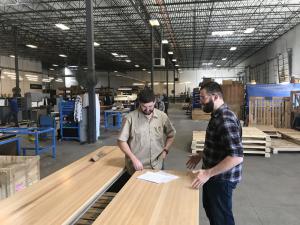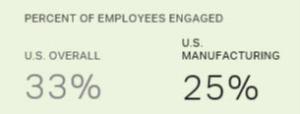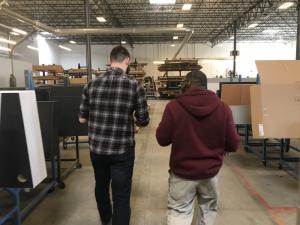How Can You Build A Better Culture in Your Manufacturing Facility?
According to Gallup, a research-based consulting company, manufacturing workers are the least engaged in their work. Can we create a better culture? Read more!
At a time when American manufacturing is poised to make a major comeback, there remains a sticking point — a looming labor shortage as many high-paid, high-tech manufacturing jobs go unfilled. We’ve written previously about the challenges manufacturing companies face in attracting the next generation of workers. In the article, we touched on the importance of improving STEM training as well as the need to create deeper ties between industry and the pool of potential workers through apprenticeship programs.
But what about improving manufacturing company culture? Isn’t that also part of the solution?
We live in a time when workers choosing a career have unprecedented visibility into a company’s culture. Social media and employer reviewing websites, such as Glassdoor, provide direct access to employee commentary of what goes on inside their workplace — at its best, and at its worst. Like Yelp restaurant reviews, savvy readers will ignore the most damning as well as the most effusive, praising reviews as they are likely to be biased. However, the bottom line is clear: if you are looking for a new career, it’s plain to see from review websites and news reports that while many professions are busy changing their office culture to make it more welcoming, accommodating, and flexible for workers, most manufacturing companies seem stuck in the past.
Workers at manufacturing companies are noticing.
According to a recent Gallup survey, the State of the American Workplace, workers at manufacturing companies are the least engaged in their work — a full 8 percentage points behind all other industry sectors. Gallup consultants point out that manufacturing workers want what they perceive their friends and family working in other industries have: more empowerment and flexibility at work, including the ability to set flex-time hours and customize their job role to better fit their needs.
Maybe it’s time to take a step back and take a look at the big picture. What aspects of manufacturing company culture needs to change for careers in manufacturing to be seen as desirable and worthwhile? Which manufacturing culture changes could help make American manufacturing more competitive in innovation, quality, and efficiency? What can be done to reduce the cost of employee turnover? And most importantly of all, how do you go about making these beneficial changes to the manufacturing culture without causing major disruption?
Here are seven recommendations you can use to change your company culture:
1. Get Started With “Keep It Simple Stupid” (KISS) Management Strategies
If you want to change the culture in your manufacturing facility for the better, it can be overwhelming to decide where to start. Don’t reinvent the wheel. Use simple, proven methods to get started.
Well-known manufacturing management techniques, such as 5S, Kaizen, and the Toyota Way, inspired by Toyota (and other Japanese firms) are good places to start. Not only do they help you get organized, they can often provide quick, positive results that will help inspire confidence in making further changes.
These programs will not only help you clean up your facilities, making them more efficient, they can also engage employees and make them take more pride in their work. But the benefits of 5S and Kaizen principles go beyond an initial organizational cleanup: these techniques can help provide you and your workers with useful visual information that will help everyone understand production bottlenecks and other trouble spots. It’s an important first step in a cultural shift toward shared responsibility for production.
Gray Engineering consultants have given us a good, real-world example: As Marty Bryant moved from Toyota to become head of operations at an automotive supplier, he realized his new employer had invested heavily in technology to gather metrics — but the information never surfaced on a daily basis to make a difference on the shop floor. The solution: a highly-visible white-board strategically placed for everyone (from the CEO to the shop worker) to see — with color coding that highlights which production processes were on track, behind plan, or stalled completely. No more hiding bad news inside weekly KPI reports!
Not sure if you are ready to tackle this yourself? Why not call on our experienced Formaspace Consultants? Our Rapid Plant Assessment program will help you quickly pinpoint problematic areas in your factory operations, such as inefficient material handling and poor workflow. Their recommendations can help you put workers first by creating efficient processes from materials handling to the manufacturing floor to the warehouse shipping and packing stations.
2. Change Work Attitudes from “It’s not my job” to “It IS my Job”
Good employees want to do good, quality work that makes a difference. But oftentimes, something gets in the way.
When workers no longer feel that their contributions can make a difference, they can feel overwhelmed by a feeling that things are out of their control. As a defensive mechanism, they often retreat into their “shell” to focus on their specific job task — and no more. This can lead to destructive conflicts to adjudicate what are “their” responsibilities versus what are the responsibilities of “others.”
Research by the consulting company PwC shows this problem surfaces across all industry sectors, not just manufacturing. In their 2017 Employee Engagement Landscape Study, the most common workplace obstacle reported by 33% of workers was, “Doing work for others that is not part of my job.” Rounding out the top five employee complaints were:
Being included in meetings unnecessarily 24%
Paperwork (e.g., reports) 23%
Lack of clear priorities 21%
Lack of clarity about the decision-making process 21%
So when you hear the phrase, “it’s not my job,” you have a problem on your hands. Your employee (who likely represents many others at your company) isn’t feeling they are part of the solution. Instead, they are saying they lack ownership and empowerment, the very characteristics needed to create a culture of quality and innovation.
How can you change the culture from “it’s not my job” to “it IS my job?”
This is a tough problem because it touches on so many aspects of the business. But we recommend starting out by promoting the role of quality and what it means for your workers — from customer satisfaction to the health of the business.
In a Harvard Business Review article Creating a Culture of Quality, authors Ashwin Srinivasan and Bryan Kurey contend that implementing these four principles can make the difference:
Leaders need to “walk the walk” on quality, not just pay lip-service.
Workers need to hear the importance from respected sources in ways that appear to them personally.
Find key influencers respected by the worker community who can use peer influence to promote the role of quality among team members.
Ensure workers know that they are empowered to speak up and make changes to improve quality.
3. Create Clear Pathways for Job Advancement, Education, and Training
Are you having trouble attracting a talented workforce? You are not the only one.
Read more ... https://formaspace.com/articles/manufacturing/build-a-better-culture-manufacturing-facility/?utm_source=einpresswire&utm_medium=content&utm_campaign=article-012918
Kelsea Marshall
Formaspace
8002511505
email us here
Legal Disclaimer:
EIN Presswire provides this news content "as is" without warranty of any kind. We do not accept any responsibility or liability for the accuracy, content, images, videos, licenses, completeness, legality, or reliability of the information contained in this article. If you have any complaints or copyright issues related to this article, kindly contact the author above.





